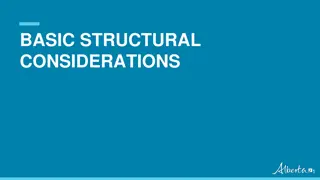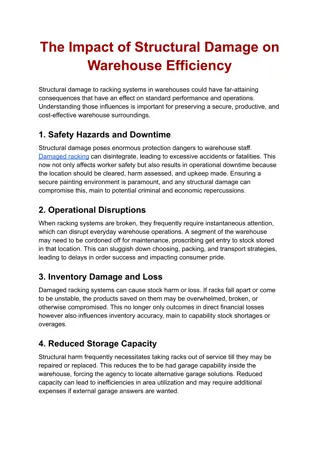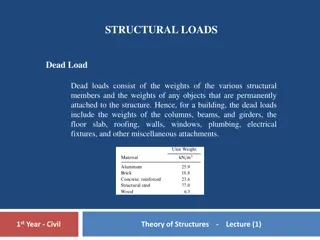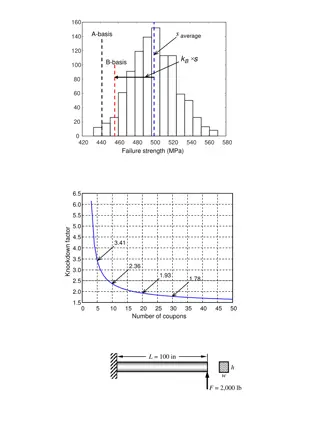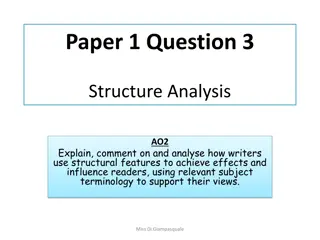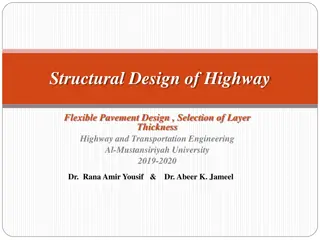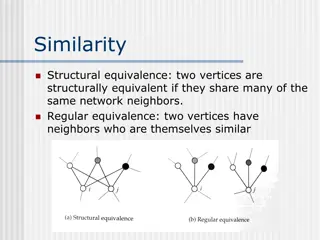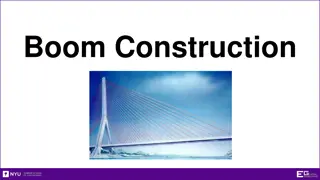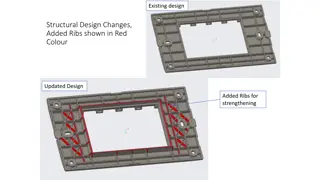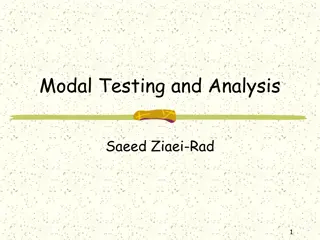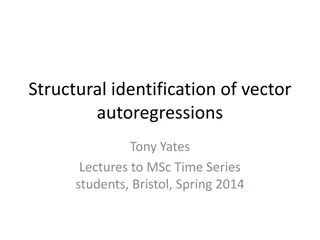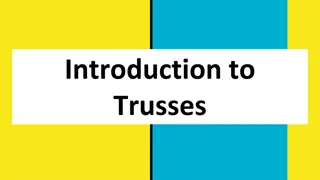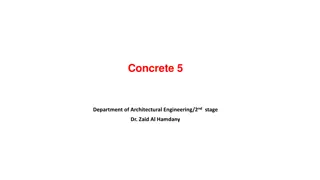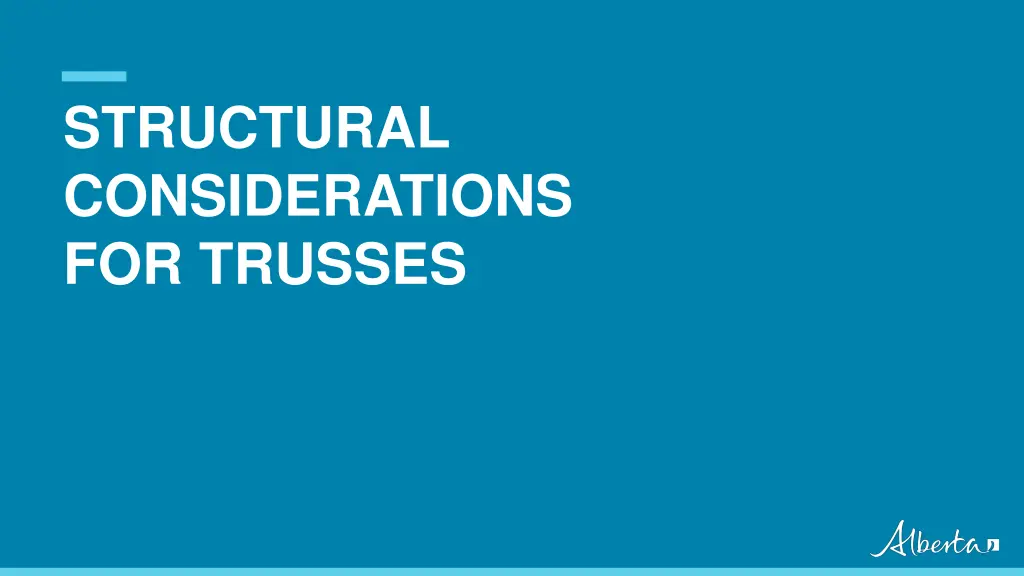
Truss Structural Considerations and Types in Alberta
Explore the structural considerations and various types of trusses in Alberta, including Pony, Through, and Deck trusses. Learn about how different truss configurations carry loads, such as Pratt and Warren trusses. Discover the importance of wind bracing and floor systems in truss design.
Download Presentation

Please find below an Image/Link to download the presentation.
The content on the website is provided AS IS for your information and personal use only. It may not be sold, licensed, or shared on other websites without obtaining consent from the author. If you encounter any issues during the download, it is possible that the publisher has removed the file from their server.
You are allowed to download the files provided on this website for personal or commercial use, subject to the condition that they are used lawfully. All files are the property of their respective owners.
The content on the website is provided AS IS for your information and personal use only. It may not be sold, licensed, or shared on other websites without obtaining consent from the author.
E N D
Presentation Transcript
STRUCTURAL CONSIDERATIONS FOR TRUSSES Classification: Protected A
Introduction U1 U2 U3 U4 U5 U6 L7 L0 L2 L5 L1 L4 L3 L6 Pratt Truss 1 Classification: Protected A
Truss Types Three types of trusses in Alberta: Pony trusses Through trusses Deck trusses Traffic loads are transferred to the trusses by a floor system. 2 Classification: Protected A
Floor System Deck supported by Stringers Truss Panel Point Wind Bracing Floor Beams supported by Trusses at Truss Panel Points Stringers supported by Floor Beams 3 Classification: Protected A
Pony Truss Wind Bracing Floor Beams 4 Classification: Protected A
Through Truss Upper Wind Bracing System Portal Brace Batter Posts 5 Classification: Protected A
Portal Brace & Batter Posts Wind Load Portal Brace Batter Posts Floor Beam 6 Classification: Protected A
Deck Truss Lower Wind Bracing System 7 Classification: Protected A
Deck Truss Wind Bracing Upper Wind Bracing System Diagonal Bracing Main Truss Members Lower Wind Bracing System 8 Classification: Protected A
Truss Configurations The way truss members carry loads depends on the configuration of the truss. Most trusses in Alberta are either Pratt or Warren trusses. 9 Classification: Protected A
Pratt Truss Top Chord Crossed Diagonals U1 U2 U3 U4 U5 U6 Vertical M1 L0 L1 L2 L3 L4 L5 L6 L7 Diagonal Bottom Chord 10 Classification: Protected A
Warren Truss Top Chord U1 U2 U3 U4 U5 U6 U7 Vertical L0 L1 L2 L3 L4 L5 L6 L7 L8 Bottom Chord Diagonal 11 Classification: Protected A
Truss Curvature Top Chord Bottom Chord Tension 12 Classification: Protected A
Loads in Diagonals U1 U2 U3 U4 U5 U6 M1 L0 L1 L2 L3 L4 L5 L6 L7 13 Classification: Protected A
Loads in Diagonals U2 U3 This side of the panel is being pulled down by the loads to the right This side of the panel is being held up by the left support L2 L3 14 Classification: Protected A
Loads in Diagonals U1 U2 U3 U4 U5 U6 M1 L0 L1 L2 L3 L4 L5 L6 L7 15 Classification: Protected A
Loads in Diagonals U2 U3 This side of the panel is being pulled down by the loads to the left This side of the panel is being held up by the right support L3 L2 16 Classification: Protected A
Loads in Diagonals U1 U2 U3 U4 U5 U6 M1 L0 L1 L2 L3 L4 L5 L6 L 7 17 Classification: Protected A
Loads in Diagonals U2 U3 This side of the panel is being pulled down by the loads to the right This side of the panel is being held up by the left support L2 L3 18 Classification: Protected A
Loads in Diagonals U1 U2 U3 U4 U5 U6 U7 L0 L1 L2 L3 L4 L5 L6 L7 L8 19 Classification: Protected A
Loads in Diagonals U2 U3 This side of the panel is being held up by the left support This side of the panel is being pulled down by the loads to the right L3 L2 20 Classification: Protected A
Loads in Diagonals U1 U2 U3 U4 U5 U6 U7 L0 L1 L2 L3 L4 L5 L6 L7 L8 21 Classification: Protected A
Loads in Diagonals U2 U3 This side of the panel is being pulled down by the loads to the left This side of the panel is being held up by the right support L2 L3 22 Classification: Protected A
Summary Loads in Diagonals Diagonals that slope away from the nearest support as they approach the bottom chord are primarily tension members. Some diagonals near the center of the truss may go into compression. Diagonals that slope towards the nearest support as they approach the bottom chord are primarily compression members. Crossed diagonals are tension members. 23 Classification: Protected A
Summary Loads in Diagonals Diagonals Slope towards nearest support approaching BC Slope away from nearest support approaching BC Crossed Tension Compression Tension 24 Classification: Protected A
Loads in Verticals U1 U2 U3 U4 U5 U6 M1 L0 L1 L2 L3 L4 L5 L6 L7 25 Classification: Protected A
Loads in Verticals U2 Top chord in compression Vertical Bottom chord in tension L2 26 Classification: Protected A
Loads in Verticals U2 Top chord in compression Vertical Bottom chord in tension L2 27 Classification: Protected A
Loads in Verticals U1 U2 U3 U4 U5 U6 M1 L0 L1 L2 L3 L4 L5 L6 L7 28 Classification: Protected A
Loads in Verticals U1 Vertical Bottom chord in tension L1 29 Classification: Protected A
Loads in Verticals U1 U2 U3 U4 U5 U6 M1 L0 L1 L2 L3 L4 L5 L6 L7 30 Classification: Protected A
Loads in Verticals U1 Vertical Bottom chord in tension L1 31 Classification: Protected A
Loads in Verticals U1 U2 U3 U4 U5 U6 U7 L0 L1 L2 L3 L4 L5 L6 L7 L8 32 Classification: Protected A
Loads in Verticals U2 Top chord in compression Vertical L2 33 Classification: Protected A
Summary Loads in Verticals Verticals connected to diagonals at both ends will be in compression if the diagonals are in tension and in tension if the diagonals are in compression. Verticals connected to diagonals at the top chord only will be in tension for pony and through trusses and will be unloaded for deck trusses. Verticals connected to diagonals at the bottom chord only will be in compression for deck trusses and will be unloaded for pony and through trusses. 34 Classification: Protected A
Summary Loads in Verticals Vertical Connected to Diagonals at both ends Diagonals at top chord Diagonals at bottom chord Diagonals in tension Diagonals in compression For pony & through trusses For deck truss For pony & through trusses For deck truss Compression Tension Tension Zero Zero Compression 35 Classification: Protected A
Summary Loads in TC, BC & BP Top chords are in compression. Bottom chords are in tension. Batter posts are in compression. 36 Classification: Protected A
Steel Sections Single Angle Double Angles Four Angles Channel W-Section Double Channel 37 Classification: Protected A
Tension Member 38 Classification: Protected A
Compression Member Misalignment of Member 39 Classification: Protected A
Compression Member Bent Member 40 Classification: Protected A
Compression Member Rippling of Plate 41 Classification: Protected A
Compression Member Rippling of Plate 42 Classification: Protected A
Compression Member Bracing 43 Classification: Protected A
Class Exercise U0 U1 U2 U3 U4 U5 U6 U7 U8 3 1 4 2 L0 L1 L2 L3 L4 L5 L6 L7 L8 44 Classification: Protected A
Class Exercise U1 U2 U3 U4 U5 U6 U7 U8 9 8 5 6 10 L0 L1 L2 L3 L4 L5 L6 L7 L8 L9 45 Classification: Protected A
Truss Loads U1 U2 U3 U4 U5 U6 U7 60 60 L0 L8 L1 L2 L3 L4 L5 L6 L7 5 10 10 10 10 10 10 10 5 40 40 46 Classification: Protected A
Truss Loads U1 U2 U3 U4 U5 U6 U7 34.6 34.6 46.2 46.2 34.6 34.6 0 0 0 10 10 10 10 L0 L8 20.2 20.2 43.3 43.3 43.3 43.3 20.2 20.2 L1 L2 L3 L4 L5 L6 L7 Compression Force Tension Force 47 Classification: Protected A
Questions? Classification: Protected A


